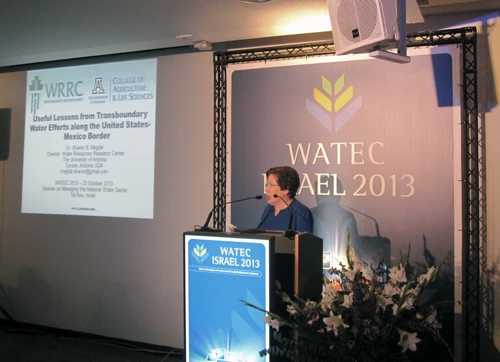Public Policy Review

I am writing this column on March 22, 2014, World Water Day (WWD) from my home in Tucson. In 2012, I spent part of WWD teaching a high school class in environmental studies in Nazareth, Israel. In 2013, I participated in the premier WWD program in The Hague. This year, I am spending this day reflecting on the two-way relevance of global connections.
For several years now, I have had the pleasure of being part of a binational team working on a transboundary aquifer assessment effort along the United States-Mexico border. We are nearing completion of binational reports for the Santa Cruz River and San Pedro River aquifers. These bilingual reports, which have been prepared within the Cooperative Framework established in 2009 by the International Boundary and Water Commission (IBWC), represent an unprecedented degree of cross-border coordination of mapping and data integration. The nature of our aquifer assessment collaboration, along with the binational collaboration on matters related to the Colorado River, where I have had less personal involvement, are of interest around the world. The IBWC and its processes for development and adoption of joint reports and Minutes to the 1944 Water Treaty, such as the historic Minute 319, can serve as models to approach transboundary efforts elsewhere.
Speaking of the Colorado River, in the past year, I worked on the paper, “A Tale of Two Rivers: Pathways for improving water management in the Jordan and Colorado River Basins”. Though the basins are far apart geographically, my three co-authors and I argue that there are common factors with respect to available policy and management options. Analysis of these factors provides insights into the similarities and divergences of the basins’ respective future pathways.
In the past year, I also continued to work on a grey water project in the Jordan Valley with colleagues from the Jordanian Royal Scientific Society. The pilot project is designed to stretch water supplies in one of the most water-stressed countries in the world. Water collected from homes is treated through a system using local filtration materials. The resulting water is then used for agricultural irrigation. In Arizona, we, too, make use of grey water – or more generally recycled water – for non-potable uses to preserve potable quality water for uses that require meeting drinking water quality standards. A recent survey of grey water policies by an Israeli researcher showed Arizona to be a leader in grey water use regulations and policies.
I have written before about the global interest in and relevance of Arizona’s groundwater management framework. As the utilization of groundwater increases to meet growing demands for water, there is increasing interest in Arizona’s framework for groundwater storage and banking. My direct involvement in groundwater recharge goes back over 20 years, to when I served as Executive Director of the (now defunct) Santa Cruz Valley Water District. It continues to this day through my service as a member of the board of directors of the Central Arizona Project and through my Arizona Water Policy class. Our class field trip focuses on artificial recharge as a mechanism for storage and treatment. I have recently collaborated with an Australian colleague and a CAP analyst on first a presentation and now a paper, entitled “Water banks: Using managed aquifer recharge to meet water policy objectives”. The paper describes the workings of the Arizona Water Banking Authority and the reasons for its implementation. For almost 20 years the statutorily authorized AWBA has been storing excess Colorado River water for times of shortage. The paper goes on to explore conditions under which water banking could successfully be applied to other parts of the world, including Adelaide, South Australia. A recent international symposium, ISMAR 8, which was held in Beijing in October 2014, has led to a special issue of the journal Water on the policy and economics of managed aquifer recharge (MAR). I am serving as lead guest editor and look forward to the compilation of papers on this subject from around the world.
These and other projects with international dimensions – including work with colleagues from the University of Arizona, UNESCO and OECD on water governance – have applications here in Arizona. Interactions with international experts provide valuable opportunities to show the relevance of our water management successes and challenges and learn from experiences abroad. However, there is no region in the world that I am aware of that has it all figured out. And water management challenges are too complex for a cookie-cutter approach. Nevertheless, efforts to identify best practices for groundwater governance, as just one example, can have relevance at all geographic levels. (See www.groundwatergovernance.org and our internal page on Groundwater Governance & Management.)
There is general agreement around the world that education at all levels and effective, inclusive stakeholder engagement and dialogue are crucial to the identification, adoption, and implementation of sound water management practices. In many cases, the obstacles to adoption are not engineering or financial, but rather political or institutional. Decision makers will want to know there is public support for their selected options. Institutional mechanisms that allow and encourage dialogue may not exist in some locales.
Many of the approaches, particularly some of those being contemplated to close Arizona’s supply-demand gap, require considerable advance planning. While the experiences of others around the world can and often will be of assistance to us, in the end the solutions in Arizona – and around the world – will most often be designed at the local and regional levels.
Postscript: The WRRC conference panel that focused on “how” we close Arizona’s gap underscored the importance of leadership. When faced with policy choices and difficult tradeoffs, implementation of solutions will require champions and involvement of a diverse set of players. More on this in our next newsletter!

